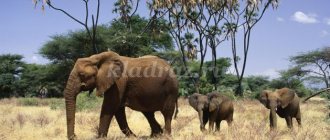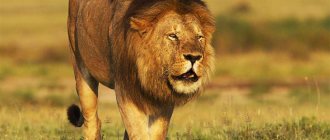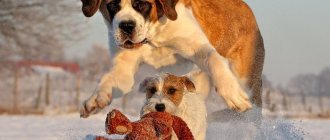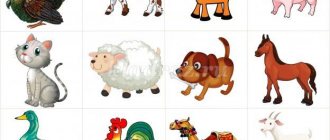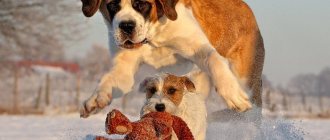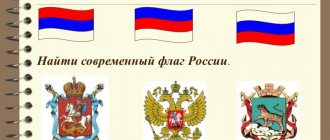Animals of hot and cold countries - Charushin E.I.
Small interesting stories about animals living in different climatic conditions: in the hot tropics, in the savannah, in the northern and southern ice, in the tundra.
Watch out, zebras are striped horses! Beware, fast antelopes! Beware, steep-horned wild buffalos!
The lion is out hunting!
It was as if thunder thundered and rolled through the bushes and thickets. This is a lion's roar, a lion's roar. And all the animals hid.
The lion is the strongest, the most terrible of all. His mane is thick, his claws are sharp, and his teeth are strong.
Who will he catch this night?
Plan – summary of GCD using ESM in the preparatory group “Animals of hot countries”
Lesson summary for the preparatory group “Wild animals of hot countries”
Goals:
Consolidating ideas about wild animals of hot countries, their appearance, lifestyle and habits.
Fostering love and respect for nature.
Objectives of using ESM
: 1. Getting to know the animals of hot countries. 2. Expanding the horizons of children. 3. Development of cognitive and research activities. 4. Development of attention and visual perception. 5. Expansion of vocabulary. 6. Instilling in children love and respect for nature.
Equipment:
magnetic board, pictures for the magnetic board, a set of magnets, a diagram for writing descriptive stories, electronic educational resources: presentation “Animals of hot countries,” computer. Progress of the lesson.
1. Organizational moment. (Announcing the topic of the lesson. Creating an emotionally positive background.) Educator. If it's cold, guys, here are some hot riddles for you. The warmest continent is picturesque and large. Many lions and monkeys live here among the savannas. (Africa).
2. Conversation about animals of hot countries. (Development of dialogical speech.) Examination with children of pictures of wild animals of hot countries. The teacher tells the children about what the animals of the hot countries where they live eat, and what their cubs are called. Characteristics of the appearance of animals are given, children's attention is drawn to parts of the animal's body (torso, head, tail, horns, hooves, shell, etc.). 3. Didactic exercise “Select, name, remember.” - Complete the sentences (select and name as many feature words, action words as possible), for example, elephant (which one?) - big, strong; tiger (what is he doing?) - growls, hunts.
4. Compilation of descriptive stories about animals of hot countries according to the scheme. The teacher places a diagram of a story about an animal on a magnetic board. Educator. Now we will compose descriptive stories about animals. First, you will say what the animal is called, where it lives, what size and color it is, what features are in the structure of the body, what its cubs are called, how it speaks, what it eats. (Several description stories are compiled about the animals chosen by the children). 5. Physical education minute.
Finger gymnastics “Where the sparrow dined.”
-Where did you have lunch, sparrow? (Children wave with crossed palms.) - In the zoo with the animals. (Palms depict an opening mouth.) - First I had lunch behind bars with a lion. (For each name of the animal, one finger is bent, first on the left, then on the right hand.) I refreshed myself at the fox’s and drank some water at the walrus’s. I ate carrots from an elephant. I ate millet with the crane. I stayed with a rhinoceros and ate a little bran. I attended a feast with tailed kangaroos. I was at a festive dinner at the shaggy bear's place. And a toothy crocodile almost swallowed me. (Again they depict the opening mouth of the animal).
Penguins
These are absolutely amazing birds - they are not like others. They fly in water, not through the air. They dive and flap their short wings so hard, they fly so fast under water that they catch up with the fish. And penguins also walk in a special way, in their own way: in columns. From a distance it seems that this man is walking in a black jacket and white vest.
One day a ship sailed into unknown cold lands. The sailors wanted to land on the shore - and suddenly they saw: a whole army lined up on the ice! We swam closer. And the army suddenly, as if on command, plunged headfirst into the water! It was only then that the sailors realized that these were not people, but birds.
The whale is the largest animal in the world. He lives in the sea, swims in the water like a fish.
A whale will swim into the cold seas, where there is only ice and snow, and it will also swim to the south, where it is hot all year round, chasing schools of fish. Where the fish go, there he goes.
A whale will capture a whole school of fish along with water in its mouth, release the water, but the fish will remain in its mouth - it will get stuck in the whalebone. Just don't think that this is really a mustache. There are these plates in the whale's mouth, like a lattice, and these lattice is called whalebone.
ECD for familiarization with the outside world in the preparatory group “Animals of hot countries”
Razilova Elena Leonidovna
NOD for familiarization with the outside world in the preparatory group “Animals of hot countries”
The goal is to consolidate and expand children's knowledge about animals of hot countries .
— clarify and broaden children’s horizons about the life of animals in hot countries ;
-form ideas about the relationships between living organisms and their environment;
- continue to learn to express your own opinions;
- develop interest in representatives of wildlife ;
— expand the active conceptual vocabulary of students;
- cultivate interest in around us and the ability to talk about its objects with adults and peers, listen carefully and complement each other’s answers;
Lesson summary “Animals of hot countries” (preparatory group)
Marina Novikova
Lesson notes “Animals of hot countries” (preparatory group)
GCD theme: Travel game “ Animals of hot countries ”
.
Age: preparatory group (6-7 years)
Direction of education and development (educational field)
: speech development.
Goal: formation of lexical and grammatical means of the language and development of coherent speech on the topic “ Animals of hot countries ”
.
- consolidate knowledge about animals of hot countries , clarify external signs, characteristic habits,
- developing skills and explaining the meaning of popular expressions;
-improving the grammatical structure of speech (formation of possessive adjectives)
;
-development of spatial concepts ;
-strengthen the skill of forming nouns in the Genitive case;
- strengthening the skill of comparison.
— activate the dictionary on this topic;
- develop fine motor skills of the hands;
-development of phonemic perception;
-development of coherent speech;
various materials to depict , to show independence in choosing material for work.
- instill in children an interest in the environment;
- cultivate a desire to communicate with each other;
-development of fantasy and imagination.
Types of children's activities: communicative, playful, motor, musical, design .
Forms of organization: subgroup , individual.
Equipment: music book, model of the savannah, toys “ animals of hot countries ”
, touch pool, silhouette of a giraffe on a piece of paper, buttons, beans,
“Carpet Box”
, geometric shapes, contact tape, map, sad and happy emoticons, coloring pages.
Hippopotamus
The hippopotamus can barely walk on its stumpy legs. The fat on it is shaking. If this fat glutton drags himself onto the field, he will devour the entire field, and what he has not eaten, he will crush. And then he goes into the river to sleep; dozes and basks on the water, like on the softest feather bed. Get some sleep, rest - and let's have fun. Here, in the water, he is not at all clumsy, but a very agile animal. It swims, dives, gets seaweed from the bottom, otherwise it opens its mouth - and it is huge, like an open suitcase - and screams, as if ten horses neighed at once.
GCD on cognitive development "Animals of hot countries"
Lesson summary for the preparatory group
"Animals of hot countries"
Developed by Soboleva I.V.
Tasks:
Teach children to create a narrative composition - placing animals in a panorama of the African savannah. Continue to develop teamwork skills and abilities.
Develop the ability to use various artistic and visual materials: watercolors, wax pencils and a simple pencil and their combinations, giving the image greater expressiveness and a more accurate embodiment of the idea.
Improve technical drawing skills, using familiar image techniques, drawing in a certain sequence.
Encourage children's independent creativity and imagination, initiative, and the ability to make additions to the composition that correspond to a given theme.
Develop cooperation and interaction skills. Fostering goodwill, independence, initiative, and emotionality.
Developmental Environment: Africa Outline; "Choice Board"; paper, watercolor paints, paint brushes, glue stick, scissors.
Audience rows
: images of a kitten, lion cub, tiger cub, horse, zebra, giraffe.
Preliminary work:
Conversation about animals of hot countries
Reading poems “Monkey” by V. Jain, “Rhinoceros” by H. Bellock, “Giraffe”, “Lion cubs”, “Zebras” by S. Marshak, “Giraffe”, “Kangaroo” by B. Zakhoder.
Examination of reproductions and photographs of African landscapes.
Acquaintance with the works of animal artists.
Getting to know the appearance of exotic animals (photos, illustrations, visual teaching aids, atlases, encyclopedias, etc.)
Drawing a compositional basis (panorama of the African savannah).
Reading the book “The ABC of Animals” by Shalaeva.
Coloring book in the animal world
Origami "Giraffe"
Progress of the lesson
Organizational part.
Meeting the guests
Children stand in a semicircle - say their names and give each other a hand. Then they all say together: We will put palm to palm
And we will offer each other to be friends.
We will sing, practice, play,
To become kind, smart, friendly.
Educator
: Children, I received a strange package today, it contains some kind of map, on it are several animals from hot countries. And, excuse me, there is also a note here: “Dear guys, I am writing to you with a big request, to draw for me animals from hot countries.
I used to have a map with all the animals, but something bad happened to me. I was caught in a big storm on my ship, the waves were so strong that they hit my cabin and blurred the map. True, there are a few animals left, but I don’t remember at all what a giraffe, elephant, lion, camel, monkey, zebra, tiger look like. I first turned to animal artists, but they didn't remember exactly these animals. I need the card urgently, all the animals in Africa are sick.
Polar bear
The polar bear is a wandering animal. This tramp's fur coat is warm; the frost does not touch it. Thick fur does not get wet in water. He doesn’t care about frost, blizzard, wind, or icy water.
A polar bear walks and wanders on the ice and snow; catches prey - a fish or a walrus, eats his fill and immediately falls asleep, right there on the ice.
And when he gets enough sleep, he wanders off again. He looks out, sniffs out someone to catch, something to fill his belly with again. He dives deftly, runs quickly, and swims easily. Such a person will not remain hungry for long; he will get food for himself.

